

An automated workflow bundles a series of pre-determined settings to define jobs.
Open the Settings Editor and go to: .
 [Automated workflows] tab
[Automated workflows] tabClick [Add].
 [Automated workflows] menu
[Automated workflows] menuDefine the settings.
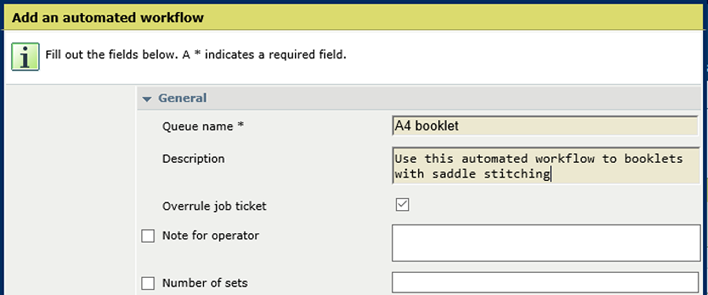 [Add an automated workflow]
[Add an automated workflow] Click [OK].
Select one of the available automated workflows.
Click [Copy].
Define the settings.
Click [OK].
You cannot rename the automated workflow: (default), but you can change its settings.
Do not change the settings of the factory default automated workflow: (default). This automated workflow is used in case no other automated workflow is addressed and changes the job settings you defined at other locations.
Select one of the available automated workflows.
Click [Copy].
Define the settings.
Click [OK].
You cannot delete the automated workflow: (default).
Select one or more automated workflows.
Click [Delete].
Be aware that this option removes all custom automated workflows.
Click [Restore].
Click [OK].
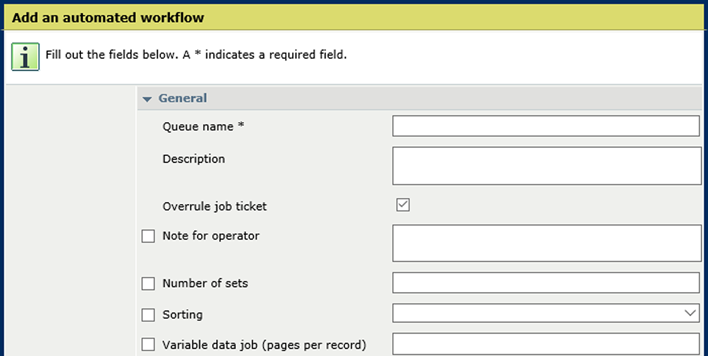 [Add an automated workflow]
[Add an automated workflow] |
Setting |
Description |
|---|---|
|
[Queue name] |
Name of the automated workflow. For LPD/LPR printing this name is the name of the queue. The label name of a job that has used an automated workflow, also refers to this name. |
|
[Description] |
Description of the automated workflow. |
|
[Overrule job ticket] |
Job settings that are defined on other locations, are by default ignored to ensure that only the settings of the automated workflow are used. |
|
[Note for operator] |
Create a print or finishing instruction for the operator. |
|
[Number of sets] |
Indicate the number of sets. |
|
[Sorting] |
Indicate if you want to sort the output per set or per page. |
|
[Variable data job (pages per record)] |
Indicate if the PDF job is handled as variable data print job. Then, enter the pages per record. |
|
[Variable data job (pages per record)] |
Use this setting to indicate that the job is a variable data job. Enter the number of pages that composes a record. |
 [Media]
[Media] |
Setting |
Description |
|---|---|
|
[Media] |
Select the media from the media catalogue. |
|
[Fit to media size] |
Indicate if the page is scaled or clipped according to the media size. |
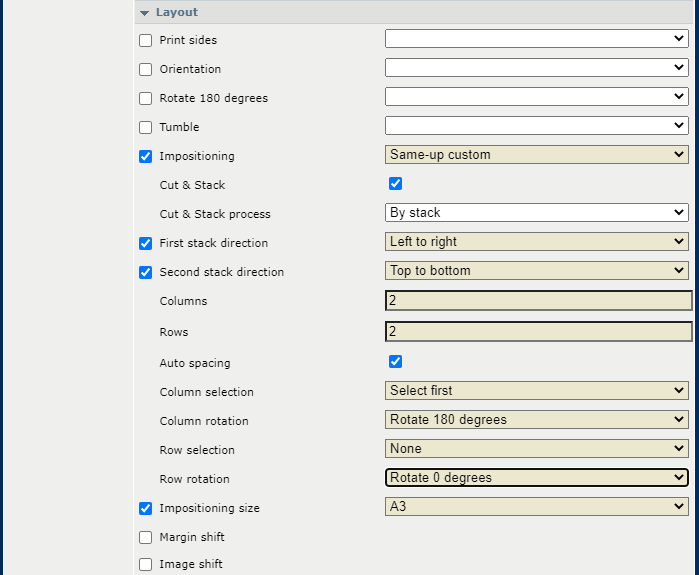 [Layout]
[Layout] |
Setting |
Description |
|---|---|
|
[Print sides] |
Indicate if the output is printed 1- or 2-sided. |
|
[Orientation] |
Indicate if the reading direction of the document is parallel to the short edge or long edge of the page. |
|
[Rotate 180 degrees] |
Indicate if pages are rotated 180 degrees. |
|
[Tumble] |
Indicate if you bind two-sided documents at the top or the bottom edge. The tumble option rotates the image on the back side of the sheet 180 degrees. |
|
[Impositioning] |
Indicate if the multiple pages are printed on a sheet, for example, to create a booklet. |
|
[Impositioning size] |
Select the impositioning size in case media are not selected. |
|
[Margin Shift] |
Define the margin shift of the front side and the back side in two directions. Enter: 0 to indicate that there is not shift required. |
|
[Image shift] |
Define the image shift of the front side and the back side in two directions. Enter: 0 to indicate that there is not shift required. |
|
If [Impositioning] is set to [Same-up custom], the following settings become available: |
|
|
[Cut & Stack] |
Indicate if you want to cut and stack the sheets. |
|
[Cut & Stack process] |
Select how you want to stack the sheets. |
|
[First stacking direction] |
Select the first stacking direction. |
|
[Second stacking direction] |
Select the second stacking direction. |
|
[Columns] |
Select the number of columns. |
|
[Rows] |
Select the number of rows. |
|
[Auto spacing] |
Indicate if you want to use the automatic gutter spacing option. The automatic gutter spacing option sizes gutters so that the document's pages fill the entire available space in the layout. The [Auto spacing] setting becomes available only if [Print trim marks] is selected. |
|
[Column spacing ({0})] |
Define the distance between columns. The [Column spacing ({0})] setting becomes available only if [Print trim marks] is selected. |
|
[Row spacing ({0})] |
Define the distance between rows. The [Row spacing ({0})] setting becomes available only if [Print trim marks] is selected. |
|
[Column selection] |
Select specific columns. |
|
[Column rotation] |
Select how you want to rotate the column(s) that you selected. |
|
[Row selection] |
Select specific rows. |
|
[Row rotation] |
Select how you want to rotate the row(s) that you selected. |
You can set [Impositioning] to [Same-up custom] only when your printer has the Advanced Impose licence installed.
 [Special pages]
[Special pages] |
Setting |
Description |
|---|---|
|
[Front or booklet cover] |
Select the media from the media catalogue. |
|
[Printing on front cover] |
Indicate if the front cover is printed. |
|
[Back cover] |
Select the back cover media from the media catalogue. |
|
[Printing on back cover] |
Indicate if the back cover is printed. |
|
[Perfect binding] |
Indicate if and where the job is bound. |
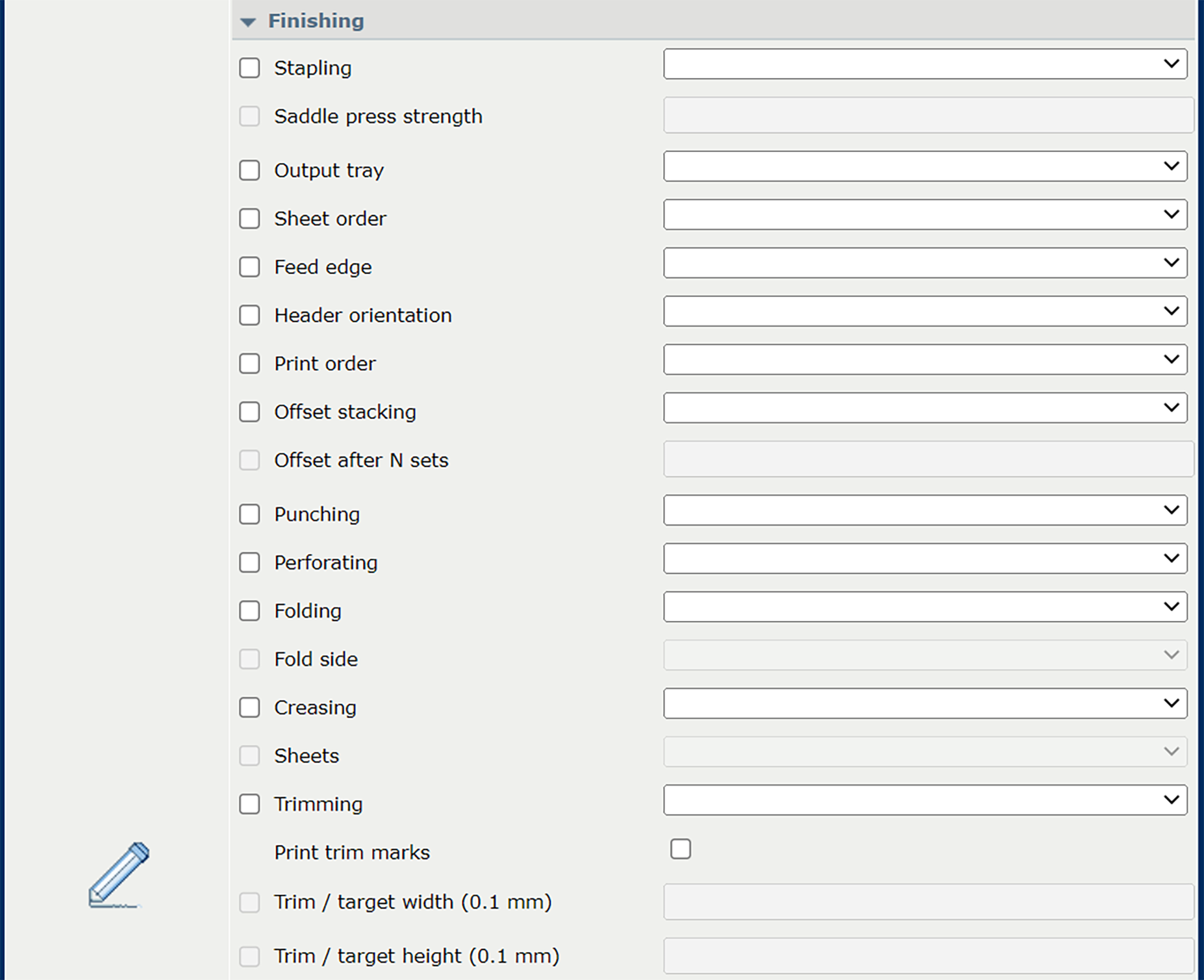 [Finishing]
[Finishing] |
Setting |
Description |
|---|---|
|
[Stapling] |
Select the staple method and location. |
|
[Saddle press strength] |
Define the value for saddle press stapling: between -10 and +10. |
|
[Output tray] |
Select the output tray. |
|
[Sheet order] |
Select the order of the sheets in the output tray. |
|
[Feed edge] |
Select the orientation of the sheets in the output tray. |
|
[Header orientation] |
Select the orientation of the sheets in the output tray. |
|
[Print order] |
Indicate the delivery order of the sheets. |
|
[Offset stacking] |
Indicate if the sets are delivered with an offset. |
|
[Offset after N sets] |
Indicate if a series of sets are delivered with an offset. |
|
[Punching] |
Select the number of punch holes and their location. |
|
[Perforating] |
Select the perforation type and location. |
|
[Folding] |
Select the folding method. |
|
[Fold side] |
Indicate the fold side: [Inside] or [Outside]. |
|
[Creasing] |
Select the creasing method. |
|
[Sheets] |
Indicate the sheets you want to crease. |
|
[Trimming] |
Select the trimming method. |
|
[Print trim marks] |
Indicate if you want to print trim marks. |
|
[Width ({0})] |
Indicate the width that must be trimmed. |
|
[Height: ({0})] |
Indicate the height that must be trimmed. |
|
[Horizontal trim shift: ({0})] |
Shift the trim marks horizontally. |
|
[Vertical trim shift: ({0})] |
Shift the trim marks vertically. |
|
[Horizontal alignment] |
Indicate if the trim marks need to be aligned horizontally. |
|
[Vertical alignment] |
Indicate if the trim marks need to be aligned vertically. |
[Horizontal trim shift: ({0})], [Vertical trim shift: ({0})], [Horizontal alignment] and [Vertical alignment] settings become available only if:
You have the Advanced Impose licence installed on your printer;
[Impositioning] is set to [Same-up custom];
[Print trim marks] is selected.
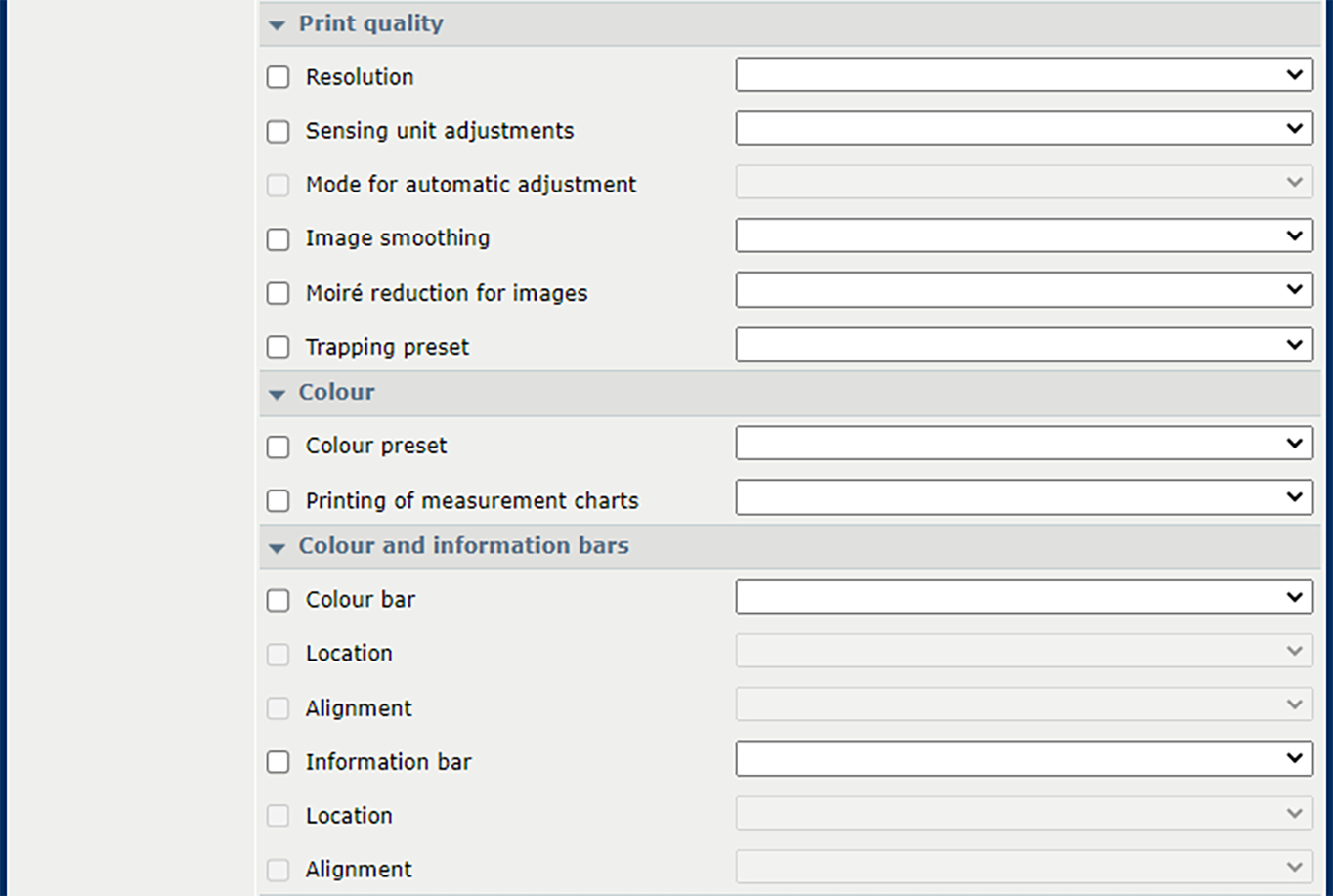 [Print quality], [Color] and [Color and information bars]
[Print quality], [Color] and [Color and information bars] |
Setting |
Description |
|---|---|
|
[Resolution] |
Use this setting to indicate the print resolution. |
|
[Sensing unit adjustments] |
Use this setting to select an automatic adjustment to be performed by the sensing unit, either: media registration, density, media registration and density or none. |
|
[Mode for automatic adjustment] |
Use this setting to select the mode for the automatic adjustment in the sensing unit: continuous or interrupt mode. |
|
[Image smoothing] |
Use this setting to apply an anti-aliasing algorithm to smooth images with a low resolution. |
|
[Moiré reduction for images] |
Apply a Moiré reduction algorithm to enhance photographic images. When images have a resolution below 300 dpi, the Moiré reduction only takes effect when image smoothing is enabled. |
|
[Trapping preset] |
Select a trapping preset. |
|
[Color preset] |
Select a colour preset. |
|
[Printing of measurement charts] |
Use this setting only for printing measurement charts for G7 calibration or external profiling. Improper use of this setting may cause pollution of the printer. |
|
[Color bar], [Location], [Alignment] |
Select a colour bar and its location. |
|
[Information bar], [Location], [Alignment] |
Select an information bar and its location. |
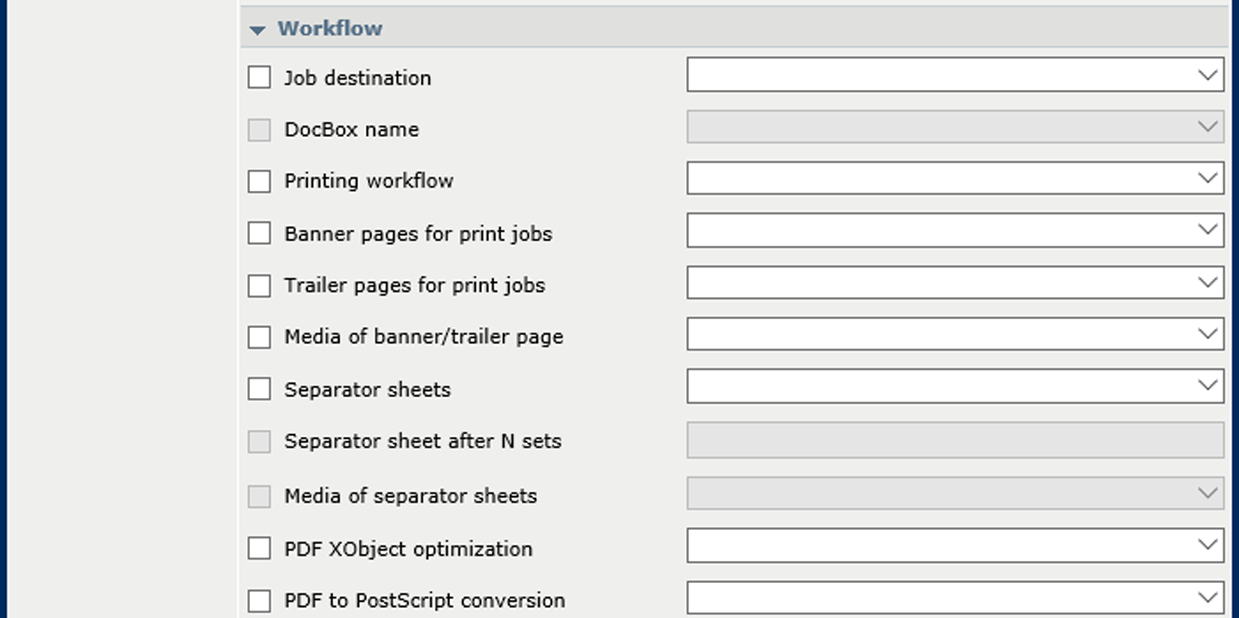 [Workflow]
[Workflow] |
Setting |
Description |
|---|---|
|
[Job destination] |
Select the destination of the jobs: scheduled jobs, waiting jobs or DocBox. |
|
[DocBox name] |
Select the DocBox. |
|
[Printing workflow] |
Select the job processing on the PRISMAsync Print Server. |
|
[Banner pages for print jobs] |
Indicate if a banner page is used. |
|
[Trailer pages for print jobs] |
Indicate if a trailer pages is used. |
|
[Media of banner/trailer page] |
Select the media of the banner and trailer page. |
|
[Separator sheets for print jobs] |
Indicate if separator sheets are used. You can use separator sets per a series of sets, if required. |
|
[PDF XObject optimization] |
Select whether PDF/X objects are cached per document or per page. |
|
[PDF to PostScript conversion] |
Indicate if you want to convert PDF to PostScript instead of only using the native PDF RIP, which is the default setting value. |
 [Accounting]
[Accounting] |
Setting |
Description |
|---|---|
|
[Accounting ID] |
Enter accounting ID. |
|
[Cost center] |
Enter cost centre. |
|
[Custom] |
Enter extra account information. |
 [Page numbering]
[Page numbering] |
Setting |
Description |
|---|---|
|
[Use page numbers], [Start with page number], [Location], [Text before page number], [Text after page number] |
Indicate if you want to use page numbers. The font and the font size are pre-defined. Indicate if and where the page numbers are printed. Enter the text that is additionally printed before or behind the page number. |